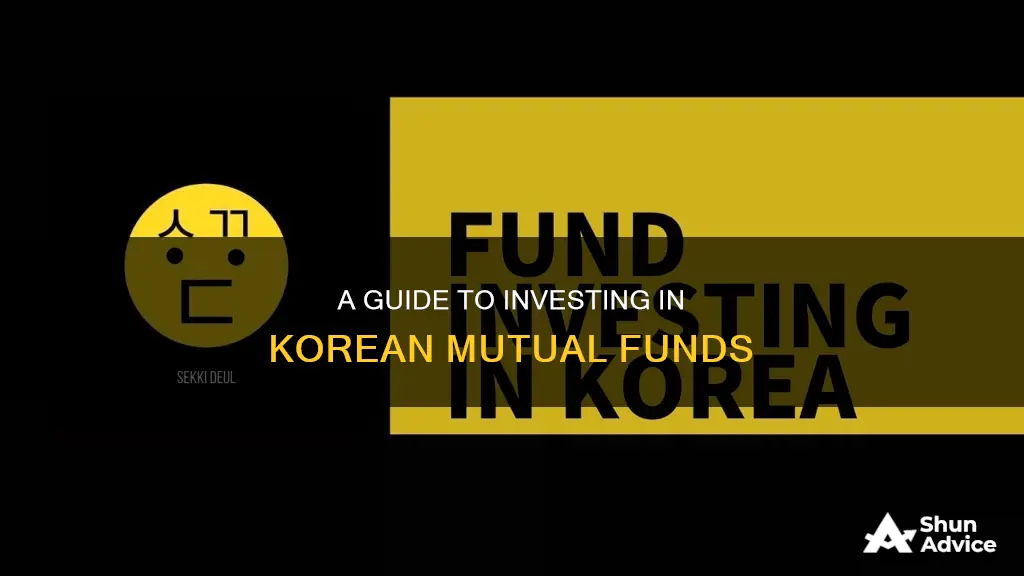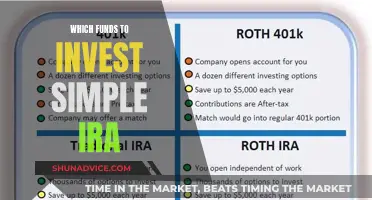
Investing in mutual funds is a popular choice for South Koreans, who refer to them as tujashintak. Over 50% of households in the country subscribe to a program where a set amount of money is deducted from their savings account each month and put into a stock fund. This has resulted in one of the most mature and resilient equity markets in Asia. South Korea's economy is the 10th largest in the world in terms of GDP, and its key sectors include automobiles, machinery, and semiconductors. Mutual funds in South Korea may be a good option for conservative-minded investors, but it's important to note that some funds don't hedge their currency risk, which can significantly impact returns.
What You'll Learn

Understand the South Korean economy
South Korea has the 10th largest economy in the world in terms of GDP and is a highly developed mixed economy. It has achieved rapid economic growth in a short period, transforming itself from a low-income to a high-income economy, and is now a global leader in innovation and technology. The country has displayed global competitiveness in various fields, including automobiles, machinery, semiconductors, mobile phones, chemicals, and steelmaking.
South Korea's economic growth has been described as the "Miracle on the Hangang River", as most of the country's industrial facilities were destroyed during the Korean War, and the country was devoid of capital and natural resources. In the early 1960s, the country pushed ahead with export-oriented economic development plans, focusing on light industrial products and raw materials. In the 1970s, the country invested in heavy chemical facilities and laid the foundation for the export of heavy industrial products. South Korea is now leading the semiconductor and display sectors.
South Korea has adopted an open market economy, allowing foreigners to invest in the country freely and encouraging domestic businesses to invest in foreign countries. The country offers various advantages to foreign investors, including tax incentives, cash support, and mitigation of land-related regulations.
The South Korean economy is heavily reliant on exports and imports, leaving the country susceptible to external economic conditions. A foreign exchange crisis in 1997 forced the country to turn to the IMF for a bailout, and the country took drastic steps to drive insolvent businesses out of the market and push ahead with industrial restructuring. Despite this setback, South Korea's economy continued to record solid growth, with its GDP more than tripling from USD 504.6 billion in 2001 to USD 1,646.3 billion in 2019.
South Korea's real GDP has expanded by an average of more than 8% per year since 1962. Nominal GDP per capita grew from $103.88 in 1962 to $20,000 in 2006. The manufacturing sector grew from 14.3% of the GNP in 1962 to 30.3% in 1987. The country's exports, which amounted to only USD 32.82 million in 1960, surpassed the USD 10 billion mark in 1977 and reached USD 542.2 billion in 2019.
South Korea's education system and the establishment of a motivated and educated populace were largely responsible for spurring the country's high technology boom and economic development. The country's economy is also characterised by a heavy reliance on trade, technological innovation, and resilience through multiple crises. South Korea spends around 4.93% of its GDP on advanced research and development across various sectors of the economy.
Monthly Mutual Fund Guide: Investing $1000 Wisely
You may want to see also

Know the types of mutual funds
When investing in mutual funds in South Korea, it is important to understand the types of mutual funds available. South Korean mutual funds and ETFs invest in a wide range of asset classes, and depending on their mandate, they can invest in equities, fixed income, commodities, and alternatives. Here is a more detailed look at these types of mutual funds:
Equities
Equities are the most common type of asset class for South Korean mutual funds. These funds invest in stocks across all sectors of the market, including key industries such as automobiles, machinery, and semiconductors. Equities can be passive, also known as index funds, or actively managed.
Fixed Income
Fixed-income funds are the second most common type of asset class for South Korean mutual funds. These funds typically invest in bonds or other debt securities that provide a fixed income stream.
Commodities
Commodity funds invest in physical commodities such as precious metals, energy products, or agricultural products. These funds can offer diversification and a hedge against inflation.
Alternatives
Alternative funds invest in non-traditional asset classes such as private equity, hedge funds, or real estate. These funds can provide access to unique investment opportunities and may have different risk/return profiles compared to traditional equity or fixed-income funds.
It is important to note that the availability and suitability of these fund types may vary depending on your investment goals, risk tolerance, and the current market conditions. It is always recommended to conduct thorough research and consult with a financial advisor before making any investment decisions.
Mutual Fund Investment: Key Factors to Consider
You may want to see also

Research fees and expenses
When investing in mutual funds, there are a variety of fees and expenses that you should be aware of, as these can have a substantial impact on your investment over time. Fees and expenses vary from fund to fund, and even small differences can translate into large differences in returns. Therefore, it is important to understand the different types of fees and expenses that may be incurred when investing in mutual funds in Korea.
Firstly, let's look at shareholder fees. These are costs associated with an investor's transactions, such as buying, selling, or exchanging mutual fund shares. Shareholder fees may include sales loads (or sales charges), which are fees paid to brokers for selling fund shares. There are typically two types of sales loads: front-end sales loads, paid when purchasing fund shares, and back-end or deferred sales loads, paid when redeeming shares. The amount of the sales load will reduce the amount of money available to purchase fund shares. It is important to note that the Financial Industry Regulatory Authority (FINRA) does not permit mutual fund sales loads to exceed 8.5%.
In addition to shareholder fees, there are also annual fund operating expenses. These are regular and recurring costs that are paid out of fund assets, rather than being charged directly to investors. However, because they are paid out of fund assets, investors are indirectly paying these expenses. Annual fund operating expenses may include:
- Management fees: paid to the fund's investment adviser for managing the fund's investment portfolio and for administrative fees.
- Distribution and/or service (12b-1) fees: paid for marketing and selling fund shares, compensating brokers, advertising, and other distribution expenses.
- Other expenses: including shareholder service expenses, custodial expenses, legal expenses, accounting expenses, transfer agent expenses, and other administrative expenses.
The total annual fund operating expenses are expressed as a percentage of the fund's average net assets and can be found in the fee table of the fund's prospectus. It is worth noting that some funds may also have additional costs that are not included in the expense ratio, such as costs associated with securities lending activities or transaction costs for buying and selling underlying securities.
When investing in mutual funds in Korea, be sure to carefully review the fund's prospectus to understand all the fees and expenses that may be incurred. Additionally, consider using a mutual fund cost calculator to compare how different fees and expenses can impact your investment returns over time.
A Guide to Investing in HDFC Mutual Fund SIPs
You may want to see also

Compare South Korean mutual funds
When comparing South Korean mutual funds, it is important to consider the different types of funds available, their investment strategies, and their performance. Here is a comparison of some key aspects of South Korean mutual funds:
Types of Funds
South Korean mutual funds can be classified into different types based on their investment strategies and structures. Some common types include:
- Equity Funds: These funds primarily invest in stocks or equities of South Korean companies across various sectors such as automobiles, machinery, and semiconductors. Equity funds are the most common type of mutual fund in South Korea.
- Fixed-Income Funds: These funds invest in debt securities such as bonds and aim to provide a steady income stream to investors. While less common than equity funds, fixed-income funds are still a significant part of the South Korean mutual fund market.
- Commodity Funds: These funds invest in commodities or assets such as gold, silver, or agricultural products.
- Index Funds: These funds are passively managed and aim to replicate the performance of a specific stock market index, such as the FTSE Korea 30/18 Capped index or the MSCI Korea 20/35 index.
- Actively Managed Funds: These funds are actively managed by fund managers who aim to outperform the market by making investment decisions based on their expertise and research.
Investment Strategies
South Korean mutual funds may employ different investment strategies depending on their objectives and the types of assets they invest in. Some common strategies include:
- Value Investing: This strategy involves investing in companies that appear to be undervalued by the market. Funds using this strategy may focus on fundamental analysis to identify stocks trading below their intrinsic value.
- Growth Investing: This strategy focuses on investing in companies with strong growth potential, typically in expanding industries or sectors.
- Income Investing: This strategy prioritizes generating a steady income for investors, often through investing in dividend-paying stocks or fixed-income securities.
Performance and Risk
When comparing South Korean mutual funds, it is crucial to consider their historical performance and associated risks:
- Performance: Look at the fund's historical returns over different periods, such as one year, three years, or five years. Compare the returns with relevant benchmarks or similar funds to assess the fund's performance.
- Expense Ratio: The expense ratio represents the annual fees charged by the fund, expressed as a percentage of the average net assets. A lower expense ratio indicates lower fees.
- Dividend Yield: For funds that pay dividends, compare the annual dividend yield, which represents the percentage of the fund's distribution paid out as dividends over a year.
- Volatility: Assess the fund's volatility or risk level by examining how much the fund's returns fluctuate over time. While higher volatility may indicate higher potential returns, it also signifies greater risk.
- Currency Risk: Some South Korean mutual funds do not hedge their currency risk. This means that changes in the value of the South Korean Won can significantly impact the fund's returns, especially for foreign investors.
Examples of South Korean Mutual Funds
- IShares MSCI South Korea ETF: This fund tracks the MSCI Korea 25/50 Index and focuses on mid-cap and large-cap South Korean companies. It has an expense ratio of 0.57% and an annual dividend yield of 0.80%. Its top holdings include Samsung Electronics Co. and SK Hynix Inc.
- Franklin FTSE South Korea ETF: This fund follows the FTSE South Korea Capped Index and is weighted towards large-cap value stocks. With a low expense ratio of 0.09%, it offers access to South Korean equities at a lower cost. Its top holdings include Samsung Electronics and SK Hynix.
- Mirae Asset Global Investments (Korea) Co. Ltd: This asset management company offers a range of mutual funds investing in various asset classes and sectors in South Korea.
- Samsung Asset Management Co. Ltd: This company provides a diverse set of mutual funds with different investment strategies, including equity, fixed-income, and index funds.
In summary, when comparing South Korean mutual funds, consider the types of funds, their investment strategies, performance, associated risks, and specific examples of funds to evaluate their potential for meeting your investment goals.
A Beginner's Guide to SPX Mutual Fund Investing
You may want to see also

Learn how to invest
If you're looking to invest in mutual funds in South Korea, there are a few things you should know.
Firstly, the South Korean economy is the world's 10th largest in terms of GDP, and it is highly advanced, relying heavily on trade, technological innovation, and resilience through multiple crises. Key sectors include automobiles, machinery, and semiconductors. As a developed market economy, investments in South Korean mutual funds may be suitable for conservative-minded investors.
However, it is important to note that some funds do not hedge their currency risk, and changes in the value of the South Korean Won can significantly impact returns.
One popular way to invest in South Korea is through exchange-traded funds (ETFs). ETFs are a type of security that tracks a set of equities or an index but trades like a stock on an exchange. There are several South Korea-focused ETFs available, such as the iShares MSCI South Korea ETF and the Franklin FTSE South Korea ETF, which offer broad exposure to one of Asia's largest economies. These ETFs hold shares of large and mid-cap South Korean companies across various sectors, including information technology, industrials, and consumer discretionary.
When considering which ETF to invest in, it is essential to look at factors such as performance over one year, expense ratios, annual dividend yield, average daily volume, and assets under management.
Another option for investing in South Korea is through mutual funds, known as "tujashintak" in Korean. These funds have become very popular among South Koreans, with more than 50% of households subscribing to the program. The program involves deducting a set amount of money monthly from a savings account and channelling it into a stock fund. This regular savings program has contributed to the maturity and resilience of South Korea's equity market.
Whether you choose to invest in ETFs or mutual funds, it is always important to carefully consider your investment objectives, risk tolerance, and conduct thorough research before investing.
A Guide to Investing in Birla Sunlife Mutual Funds
You may want to see also







